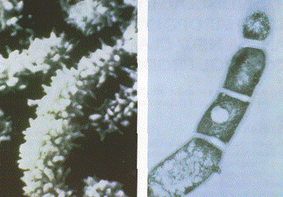Saccharopolyspora spinosa
Classification
Domain: Bacteria
Phylum: Actinobacteria
Class: Actinobacteria
Order: Actinomycetales
Family: Pseudonocardiaceae
Genus: Saccharopolyspora
Species
Saccharopolyspora spinosa
|
NCBI: [1] |
Description and Significance
Describe the appearance, habitat, etc. of the organism, and why you think it is important.
In 1982, researchers vacationing in the Virgin Islands discovered the actinomycete bacteria, Saccharopolyspora spinosa, in soil collected at an inoperative sugar mill rum still (##ref, ##ref). Similar to other species in the Saccharopolyspora genus, S. spinosa are aerobic, gram-positive, and have mycelium. The mycelium are made up of pale yellowish-pink aerial hyphae. These hyphae are long bead-like spore chains that are surrounded by spiny spore sheaths.
The discovery of S. spinosa has led to a plethora of research regarding potential applications of secondary metabolites produced by the bacteria.
Genome Structure
Describe the size and content of the genome. How many chromosomes? Circular or linear? Other interesting features? What is known about its sequence?
Cell Structure, Metabolism and Life Cycle
Interesting features of cell structure; how it gains energy; what important molecules it produces.
Saccharopolyspora spinosa is part of the family actinomycete. It produces a natural, low-risk insecticidal chemical called Spinosad. This chemical is already in use as a grain protect-ant in several countries. Spinosad protects against a large range of insects,, predominantly moths and beetles. This chemical compound is able to remain viable in dry grain storage bins and its length of virility has been measured to last from si months up to two years. The effectiveness of this compound is still being explored and it is reported that its strength is determinant upon several factors such as: insect species, pest life stage, grain type, and grain variety. Spinosad has also been marketed as a treatment for headlice under the pharmaceutical name Natroba.
Ecology and Pathogenesis
Habitat; symbiosis; biogeochemical significance; contributions to environment.
If relevant, how does this organism cause disease? Human, animal, plant hosts? Virulence factors, as well as patient symptoms.
References
Author
Page authored by Emily Pochubay, Matt O'Grady, Placid, and Demetrious Parker students of Prof. Jay Lennon at Michigan State University.
<-- Do not remove this line-->

